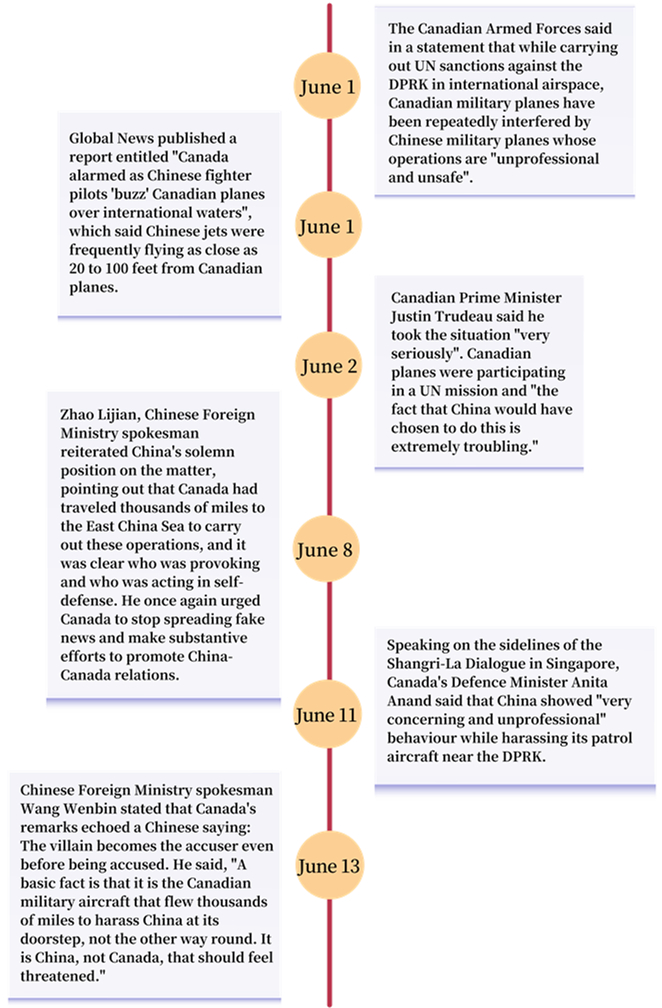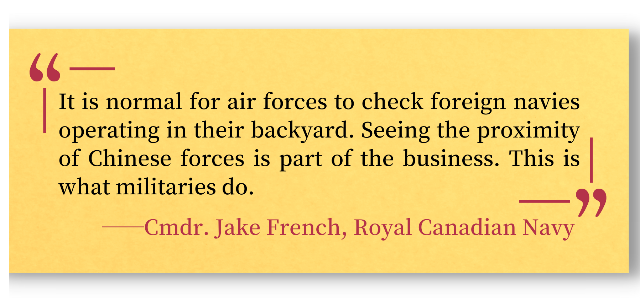
Recently, Canada has accused China of harassing its military jets over the East China Sea, calling the situation “extremely troubling” and “putting people at risk”. Canada insists its military personnel were conducting Operation NEON in the region, which aims to support the implementation of UN Security Council sanctions imposed against the DPRK.
In response, China’s Ministry of National Defense stated that Canadian military aircraft stepped up close-range reconnaissance and provocations against China under the pretext of implementing the UN Security Council Resolutions, which endangers China’s national security. Meanwhile, China’s Foreign Ministry urges Canada to “stop spreading disinformation” and “work toward the recovery and normal development of China-Canada relations with real action”.

Timeline of Canada's hype of jet encounters. (Photo/GDToday)
Questions remain to be answered regarding the dispute: Has the United Nations authorized Canada to conduct surveillance operations near Chinese airspace? What is the real target of Canada’s Operation NEON?
UN resolutions did not authorize Canada’s operations
Ottawa has repeatedly claimed that it was conducting operations to support the implementation of UN sanctions against the DPRK. The sanctions are mainly imposed by Resolution 1718 and Resolution 1874 of the UN Security Council. But have these resolutions authorized “close-up” surveillance by Canadian military planes near China’s airspace?
Resolution 1718 was unanimously passed in 2006 in response to the DPRK’s first nuclear test, preventing any transfer to the DPRK of weapons of mass destruction-related programmes by all Member States.
The UN Security Council enhanced sanctions and passed Resolution 1874 in the aftermath of another DPRK nuclear test, calling upon all Member States to inspect all cargo to and from the DPRK in their territory or vessels on the high seas.
However, it should be noted that Member States are empowered to inspect the ships on the high seas only if they have reasonable grounds to believe the vessels contain banned cargo, according to Resolution 1874. Moreover, Resolution 1718 has explicitly requested all Member States to act “in a manner consistent with their international obligations”.
Therefore, the UN Security Council has never authorized any country to deploy military forces and conduct surveillance activities near or over other countries’ territorial seas on the grounds of detecting activities violating the resolutions.There are suspicions that Canadian military jets flew across the Pacific Ocean for other covert operations, under the guise of routine surveillance and sanctions-monitoring missions.
Moreover, the CP-140 Aurora Canada dispatched to the East China Sea is an aircraft intended for anti-submarine warfare work and capable of tracking, deterring and destroying submarines. The real mission of the Canadian jets may be to detect China’s military activities in the sea.
Operation NEON has done more than sanctions-monitoring
Created in April 2019, Operation NEON was first conducted under Canada’s Operation PROJECTION Indo-Pacific, aiming to monitor and deter DPRK maritime sanctions evasion activities. In the same year, the first tripartite meeting among leaders of the DPRK, ROK and US was held at the end of June, leading to a period of rapprochement between the DPRK and Western countries. Therefore, Operation Neon was also less intrusive at the time.
On June 24, 2019, a pair of Chinese Su-30 fighter jets “buzzed” HMCS Regina when the Canadian warship carrying out Operation Neon passed through the so-called “disputed waters” in the East China Sea.
The day after the encounter, Regina’s captain Cmdr. Jake French expressed an understanding of China’s justifiable defence in an interview, saying Canada’s relations at sea with the Chinese military have been “professional and cordial”. The incident did not draw too much media attention at the time.

Why has Canada reversed its attitude towards these encounters?
"After the Russia-Ukraine conflict, there are voices that compare the tension in the Asia-Pacific region to the situation in Europe. The actions taken by the US and its allies have caused the tension to ratchet up," said Ge Hongliang, senior research fellow of the Charhar Institute and head of the China-ASEAN Center for Maritime Security at Guangxi University for Nationalities, in an interview with Sputnik.
It is in the interest of US and its allies to maintain their influence on the Korean Peninsula while keeping China in check, according to a former South Korean naval commander quoted in a Financial Times report.
Operation NEON is not only a sanctions-monitoring programme any more.
Co-presented by GDToday and School of Journalism and Communication, Jinan University
English authors | Edward (intern), Lydia Liu
Investigators | Li Fuying, Zhang Xiao
Poster designer | Mia
Editors | Wing, Ma Liming, Keane, Steven, Jerry
















